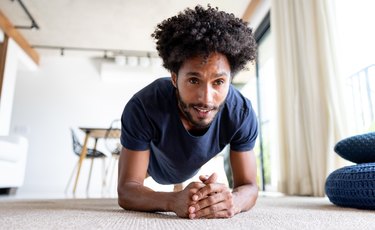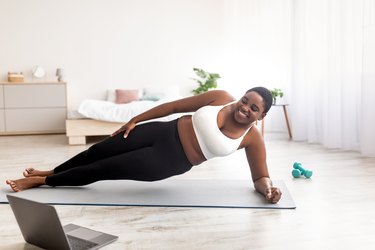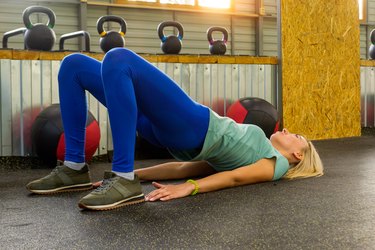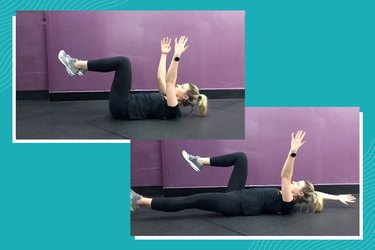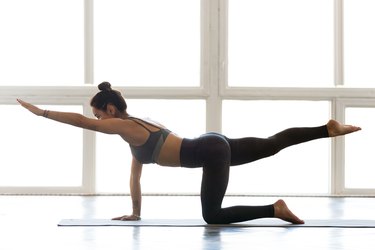
When you think about core strength you might think of six-pack abs, but the strength of your core has very little to do with how your midsection looks. It does, however, have everything to do with how your body moves and functions. Core strength is the ability to position and maintain your body in good postures, according to Harvard Health Publishing.
When you think about it in these terms, core strength is an essential part of functional movements and necessary for kids' and teens' healthy development. For a strong core, you need to focus on the abdominal and back muscles as well as the muscles surrounding the pelvis, according to the Mayo Clinic.
Video of the Day
The good news is, most able-bodied children gain core strength just by playing and moving like, well, kids. But there are ways to improve core stability safely to ensure they are moving with better posture, endurance, stability and control.
We chatted with Erica Coviello, CPT, an RRCA level 2 certified youth coach, and Tom Martins, CPT, operations manager and head coach at Bolt Fitness and Performance, about the best ways to incorporate core strengthening into kids' fitness routines.
Are Core Workouts Safe for Kids?
There are safe ways for children of all ages to improve their core strength. When it comes to younger kids ages 6 to 10, core strengthening exercises should happen through fun. (It's also important to note: We should still allow kids to be kids, and that doesn't necessarily mean structured fitness or body-specific goals, which have been linked to increases in body image issues or disordered eating.)
"Run, jump, climb, swing, hang — move in all three planes of movement in real, unstructured environments," Coviello says. "Ideally, kids don't have to train to have a strong core because their lives should be active enough to naturally build the healthiest version of their bodies. But in today's ever-increasingly sedentary society, we know so many kids aren't living the ideal lifestyle."
If you're a parent or guardian of a young child and you notice they have poor posture, difficulty sitting in one position, wobbly balance and problems with their motor skills, your child might lack core strength. Before you start making them do sit-ups (seriously, do not do this, as it can lead to body image issues mentioned above), it's best to talk to your child's pediatrician and even get a referral to a pediatric physical therapist.
But if they're interested in working out with you or if they need a bit more movement in their lives, Martins has excellent ideas for you to help them learn to love being active while they build a stronger core.
"The goal is just getting them to move their body," he says. "When they're young, we want them to learn where their body is in space." This concept is known as proprioception, and it's important because "it plays a large role in self-regulation, coordination, posture, body awareness, the ability to focus and speech. Proprioception is the sense that lets us know where our different body parts are, how they move and how much strength our muscles need to use," according to Occupational Therapy Australia.
But when he works with children under 10, he doesn't say, "OK, we're going to do 10 reps of squats" because we want to teach them to be kind to themselves and move because it brings them joy Instead, he breaks down that movement within a game.
"We'll play Simon Says," he explains. "I'll say 'drop your butt between your feet, keep your whole foot flat on the ground, chest up.' I try and teach them the fundamentals of quality movement, but in a fun way because we want them to build a positive relationship with fitness and health."
Martins also suggests playing hide and seek with kids, taking them hiking and bringing them to the playground often to help build their core strength. (For more ideas on what to include in a core-strengthening round of Simon Says, see the routine for youngsters below.)
Coviello has seen firsthand in her 25 years of coaching youth sports how kids and parents can take training too far.
"With strength training for kids, there's a fine line between gaining strength with a purpose — like athletic performance, total body health, fitness, etc. — versus overtraining due to vanity or pressure to perform," she says. "Find the line and don't cross it! The goal of all youth sports and fitness is to make it fun and functional. Don't treat them like small adults. Their bodies are still developing and don't need the extra mental or physical stress of overtraining."
When a child gains maturity, you can begin to implement more targeted routines to help them with their core strength and endurance and overall movement if it's something they're interested in. (Again, don't force them!) For instance, an August 2020 study in the International Journal of Environmental Research and Public Health studied how a six-week dynamic, core-conditioning warmup routine affected the core strength and overall movement of children 10 to 11 years old.
They implemented 10 minutes of these basic moves — like high knees, planks, lunges and burpees — as part of a 45-minute physical education class and compared it to a control group that performed three minutes of warmup jogging and static stretching. The group of children who went through the dynamic warmup performed better on basic functional movement and core endurance tests at the end of the study.
Once a child gets to age 12, Martins says they can begin to introduce the concept of a workout routine, especially for young athletes who enjoy sports and/or are enrolled in sports. "As they get older, you make the workouts as complex as the maturity level allows," he says.
Adolescents who need or want more core strength can handle a more advanced routine that focuses on stability first. Coviello notes that a core-strengthening routine is just one piece of the puzzle. Mixing up sports and activities is an even more effective way to build strength.
"Multi-sport athletes have a better chance of naturally developing a strong core," she says. "That's because their movements are more varied, with less chance of under-developed or inactive muscles and fewer overuse injuries."
No, Kids Don't Need to Train for Six-Pack Abs
The question of how to get six-pack abs is a common one, thanks to society's obsession with muscle tone (the tension of a muscle at rest). For decades, the messaging has conflated good fitness and health with visible abs. Martins says having visible abdominal muscle is largely genetic. Some kids — just as adults would too — are going to have six-pack abs just because that's the way they are built.
"It's just the way that your body holds itself," Martins says. "It's where the tendons and the striations show. Being really good at sports is your ability to move your body efficiently. Whether you can see your abs or not, that doesn't matter."
But Martins says that gaining a six-pack shouldn't be the reason to work out — at any age. He further cautions that six-pack abs can be an indication that a child or teen is not eating enough calories, which is not only counterproductive to core strength but downright dangerous.
"Do we need six packs? No," he says. "Kids need to learn how to be kids and they need to move, and they need to move properly."
Martins says most kids won't start to put on muscle mass until they're about 12 years old, and even then, he doesn't advise paying too close attention to their physique. While 12-year-olds could hypothetically gain six-pack abs, it won't come easy to all of them, and it should not be a priority.
Kid-Friendly Core Exercises
Prep for Core Strength
Coviello begins all ages with a preparatory exercise called breathing and bracing to help people find their core muscles.
How to do breathing and bracing: Inhale, fill your lungs and expand your belly, exhale, pull your belly button toward your spine, engage your transverse abdominis muscle (the deepest of all the abdominal muscles) and slightly tilt your pelvis toward your face. Repeat 10 times.
Core-Strengthening Moves for Ages 6 to 10
1. Simon Says: Before starting the game, demonstrate each movement and have them mirror what you're doing. Check for correct form. Mix in other, simpler movements (like pat your head, rub your tummy, jump one time, spin in a circle) to keep it light and fun.
2. High Knees: Run in place but bring your knees up to your chest.
3. Mummy Kick: Stand up with your arms straight in front of you at shoulder height, like you're walking like a mummy. Kick your legs out, right then left, and continue to alternate sides and cross your arms, keeping them straight out in front, at the same time.
4. Single-Leg Hop: Stand on your right foot and hop up and down. Then stand on your left foot and hop up and down.
5. Crab Walk: Sit on your bottom with your knees bent, feet flat and hands flat on the floor beside your butt. Lift your butt off the floor and hold yourself up with just your hands and feet. Crab walk forward, backward and sideways.
Core-Strengthening Moves for Ages 10 to 17
The following exercises can help develop the strength and stability to make a child a better overall athlete. The time you hold each move will vary based on age and ability. Start with 30 seconds and work your way up by increments of five. Complete two sets.
1. Plank
- Lie face down on your belly with your palms on the floor underneath your shoulders and your feet flexed with the bottoms of your toes on the floor.
- Take a deep breath and press through your palms to lift yourself up into the top of a push-up position. Your body should make a straight line from your heels through your hips to the top of your head.
- Draw your navel toward your spine and squeeze your glutes.
- Look at the floor directly below your head to keep your neck in a neutral position, and breathe normally.
Tip
You can make a plank easier by dropping down to your knees, as demonstrated in the second half of the video above.
2. Side Plank
- Lie on your side with your legs and feet stacked on top of each other.
- Prop yourself up on your forearm.
- Keeping your knees straight, stiffen your torso and lift your hips off the ground, balancing on your forearm and outer foot
- Hold, then slowly lower back down.
- Repeat on the opposite side.
Tip
You can make side planks easier by dropping your bottom knee to the ground or even dropping both knees to the ground.
3. Glute Bridge
- Lie on your back with your arms resting by your sides, knees bent and feet flat on the ground hip-width apart. Your feet should be close enough to your hips that if you reach one hand at a time toward each heel, you can just touch it with your fingertips.
- Relax your arms alongside your body. Think of your shoulders being "glued" to the floor to help keep your spine neutral.
- Squeeze your glutes and core, and press your heels into the ground to drive your hips up toward the ceiling until you form a diagonal line from knees to hips to chest. Resist the urge to arch your lower back as you raise your hips. Focus on keeping your spine in a neutral position throughout.
- Hold this position for a few seconds with your glutes engaged.
- Slowly lower your hips back down to the ground and reset in the starting position for a second before lifting back up.
4. Dead Bug
- Lie flat on your back with both arms reaching straight toward the ceiling.
- Lift your feet off the ground so your legs are bent at a 90-degree angle.
- Keep your lower back in contact with the floor through the entire duration of the exercise.
- Slowly and with control, extend one arm and the opposite leg away from each other.
- Move from the hip and the shoulder, keeping your spine steady.
- Keep your limbs long and low to the floor, forming a diagonal line.
- Lower your limbs as far as you can while keeping the lower back on the ground. Fight the impulse to arch your back by tightening your abs, pressing your bellybutton down to anchor your lower back to the floor.
- Exhale as you return your arm and leg to starting position with the same slow, controlled movement.
- Repeat with the other arm and leg, then return to center again. This counts as one rep.
5. Bird Dog
- Get on your hands and knees with your hands directly in line with your shoulder and knees in line with your hips.
- Look down at the floor and brace your core (tucking your tailbone just slightly) to create a straight line from the tip of your head to your tailbone.
- On an exhale, reach your left arm straight out in front of you until your upper arm is in line with your ear.
- Simultaneously reach your right leg straight behind you, fully extending your knee.
- Pause here for a moment.
- Reverse the motion and return to the starting position.
- Switch sides, reaching your right arm forward and raising your left leg back.
- Pause and then go back to the starting position.
Learn More About the Core Exercises Above Here!
- Harvard Health: "Understanding and Improving Core Strength"
- Mayo Clinic: "Core-strength exercises"
- International Journal of Environmental Research and Public Health: "Effect of a Six-Week Core Conditioning as a Warm-Up Exercise in Physical Education Classes on Physical Fitness, Movement Capability, and Balance in School-Aged Children"
- International Journal of Environmental Research and Public Health: "Table 1: Dynamic core stability program"
- Occupational Therapy Australia: "What is Proprioception and Why Is It Important?"
- Signs of Core Weakness in Kids
- Core Stability Activities for kids
- Relationship between functional movement screen scores, core strength, posture, and body mass index in school children in Moldova.
